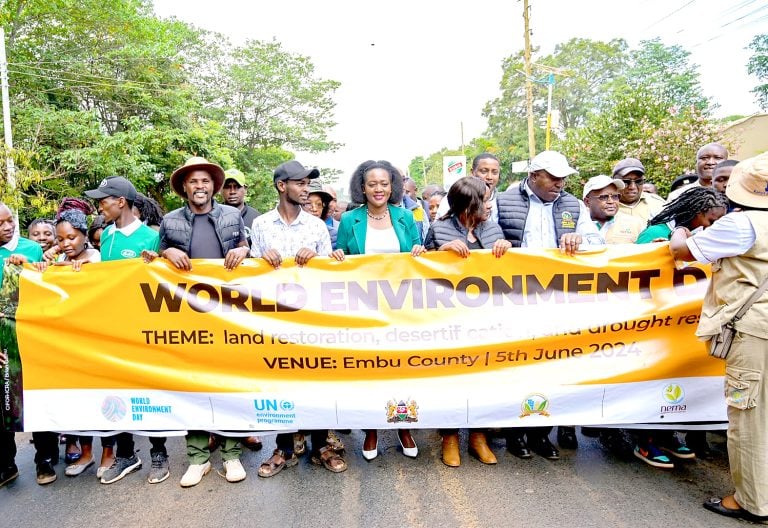Kenya’s environmental future in focus on World Environment Day 2025
By David Kipkorir, June 5, 2025As Kenya joins the global community to mark World Environment Day today, the urgency of ecosystem restoration resonates deeply in a nation where environmental health is intertwined with livelihoods, food security and economic stability.
This year’s theme, directed towards restoring ecosystems, is a clarion call for Kenyans to confront the escalating challenges of deforestation, water scarcity and climate change.
From the bustling streets of Nairobi to the agricultural heartlands of Nakuru, World Environment Day 2025 offers a moment to reflect on the environmental journey, celebrate its successes and commit to bold, collective action for a sustainable future.
The ecosystems—their forests, wetlands and savannas—are under siege.
The Mau Forest Complex, one of Kenya’s vital water towers, has lost over 25 per cent of its forest cover in recent decades due to illegal logging and encroachment, threatening water supplies for millions in Nakuru, Eldoret, and beyond.
Wetlands like Lake Naivasha, critical for biodiversity and agriculture, face pollution and over-extraction.
According to the Kenya Forest Service (KFS), the country’s forest cover has improved to 8.8 per cent from a low of 5.9 per cent in 2000, thanks to reforestation efforts, but it remains below the required target of 10 per cent.
World Environment Day 2025 is a reminder that restoring these ecosystems is not just an environmental necessity but a socio-economic imperative for Kenya’s 56 million people.
Ecosystem restoration demands action at every level. The government has made strides, such as the 2017 ban on single-use plastics, which reduced plastic pollution in urban centres like Mombasa and Nairobi.
Sustained efforts
However, enforcement remains a challenge, with illegal dumping still clogging rivers like the Nairobi River.
The National Tree Planting Campaign, launched in 2022 to plant 15 billion trees by 2032, is a bold step, but its success hinges on sustained funding and community involvement.
The government should use this World Environment Day to strengthen policies like the National Climate Change Action Plan, incentivising green energy and sustainable agriculture.
Kenya’s geothermal potential in the Rift Valley and solar projects in Garissa could position the country as a renewable energy leader, but scaling these requires investment in infrastructure.
Local businesses, too, must step up.
In Nakuru, where Jamii Sacco recently opened a branch, financial institutions could champion green financing, offering loans for eco-friendly enterprises like organic farming or solar panel installation.
Small and medium enterprises, which form the backbone of Kenya’s economy, can adopt sustainable practices, such as reducing waste or using biodegradable packaging.
The success of companies like Ecocycle Kenya, which recycles plastic into building materials, shows that profitability and environmental responsibility can coexist.
World Environment Day should inspire Kenya’s private sector to integrate sustainability into their models, supporting the country’s Vision 2030 goals.
Communities are the heart of Kenya’s environmental movement.
The legacy of Wangari Maathai’s Green Belt Movement, which has planted over 50 million trees, continues to inspire grassroots action.
In Nakuru, community groups are restoring degraded lands around Lake Nakuru National Park, protecting its flamingo population and boosting eco-tourism.
Yet, rural farmers and urban youth need more support—through training, seedlings, or access to markets—to sustain these efforts.
On World Environment Day, schools across Kenya, from Kisumu to Kilifi, should host tree-planting drives and environmental education programs to nurture a generation of eco-conscious citizens.
The vibrant youth movement, seen in groups like the Kenya Climate Change Working Group, can amplify these efforts by using social media to spread awareness.
Individual actions matter profoundly in Kenya, where small choices—like using reusable bags or conserving water—can ease pressure on strained resources.
In informal settlements like Kibera, where waste management is a challenge, community clean-ups can make an immediate impact.
Climate justice
However, systemic barriers, such as limited access to recycling facilities or affordable clean energy, must be addressed to empower individuals.
County governments, particularly in urban hubs like Nakuru and Eldoret, should invest in waste collection systems and public awareness to complement individual efforts.
Climate justice is a pressing issue in Kenya, where marginalised communities bear the brunt of environmental degradation.
Pastoralists in Turkana face prolonged droughts, while coastal communities in Lamu grapple with rising sea levels.
These groups contribute little to global emissions yet suffer the most.
World Environment Day 2025 should push Kenya to advocate for global climate finance, like the Loss and Damage Fund, to support adaptation in vulnerable regions.
Locally, devolved funds should prioritise climate-resilient infrastructure, such as water harvesting systems in arid areas.
As we commemorate World Environment Day, Kenya’s blend of challenges and opportunities comes into focus. The nation’s resilience, seen in its community-led conservation and renewable energy strides, is a beacon of hope.
As Wangari Maathai said, “We are called to assist the Earth to heal her wounds.” This World Environment Day, let’s answer that call with action, unity, and hope for a greener Kenya.
